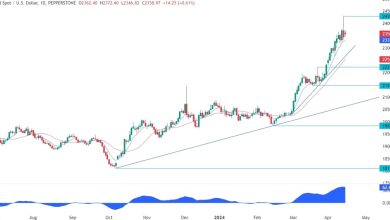April flash services PMI in the euro zone: 52.9 versus 51.8 expected

- Before 51.5
- Manufacturing PMI 45.6 versus 46.6 expected
- Before 46.1
- Composite PMI 51.4 versus 50.7 expected
- Before 50.3
The services sector is at its highest level in 11 months while that of the manufacturing sector is at its lowest in 4 months. But overall, the euro zone economy is expected to grow in April at its fastest pace in almost a year. Although economic conditions are at least improving, pricing pressures are expected to intensify slightly as the month progresses. The HCOB notes that:
“The euro zone got off to a good start in the second quarter. The HCOB Flash Composite PMI took a significant step into expansionary territory. This development was propelled by the services sector, where activity further accelerated. Taking into account various factors, including the HCOB PMIs, our GDP forecast suggests an expansion of 0.3% in the second quarter, matching the growth rate seen in the first quarter, both measured relative to the previous quarter.
“Several factors indicate that the recovery of the private services sector, which dominates the overall economy, is poised to sustain. Firstly, new business dynamics have been positive over the past two months, which also translates into a bolder recruitment policy. Second, stronger increases in product prices are not only a response to faster rising input costs, but also reflect service providers’ confidence in pricing. Finally, the recovery is occurring simultaneously in the two most significant economies in the Eurozone, Germany and France. This suggests the presence of common factors such as lower inflation and higher wages, which strengthen purchasing power and contribute to the resurgence of the services sector.
“PMI figures are poised to test the ECB’s willingness to cut interest rates in June. The accelerating rise in input costs, likely driven not only by rising oil prices but also, more worryingly, by rising wages, is drawing scrutiny. Meanwhile, companies in the services sector raised prices at a faster pace than in March, fueling expectations that services inflation would persist. Despite these factors, we expect the ECB to cut rates in June. We doubt, however, that the central bank will adopt a “pragmatic speed”, as the ECB’s François Villeroy de Galhau suggests. Rather, we expect a more cautious approach.
“The best that can be said of the manufacturing sector in the eurozone is that output fell at the slowest pace in a year in April and job losses eased somewhat. For the rest, the picture remains rather bleak, with new business continuing to decline rapidly, as do order books. The weak demand for industrial products is also reflected in the sharp decrease in the volume of inputs purchased and in the absence of a reversal in the inventory cycle. Although we expect the manufacturing sector to recover by mid-year, it is essential to consider the structural factors influencing the sector. China, whose companies are increasingly competing with local industrial companies, particularly in the field of high-tech products, could play an important role in this regard.
cnbctv18-forexlive




